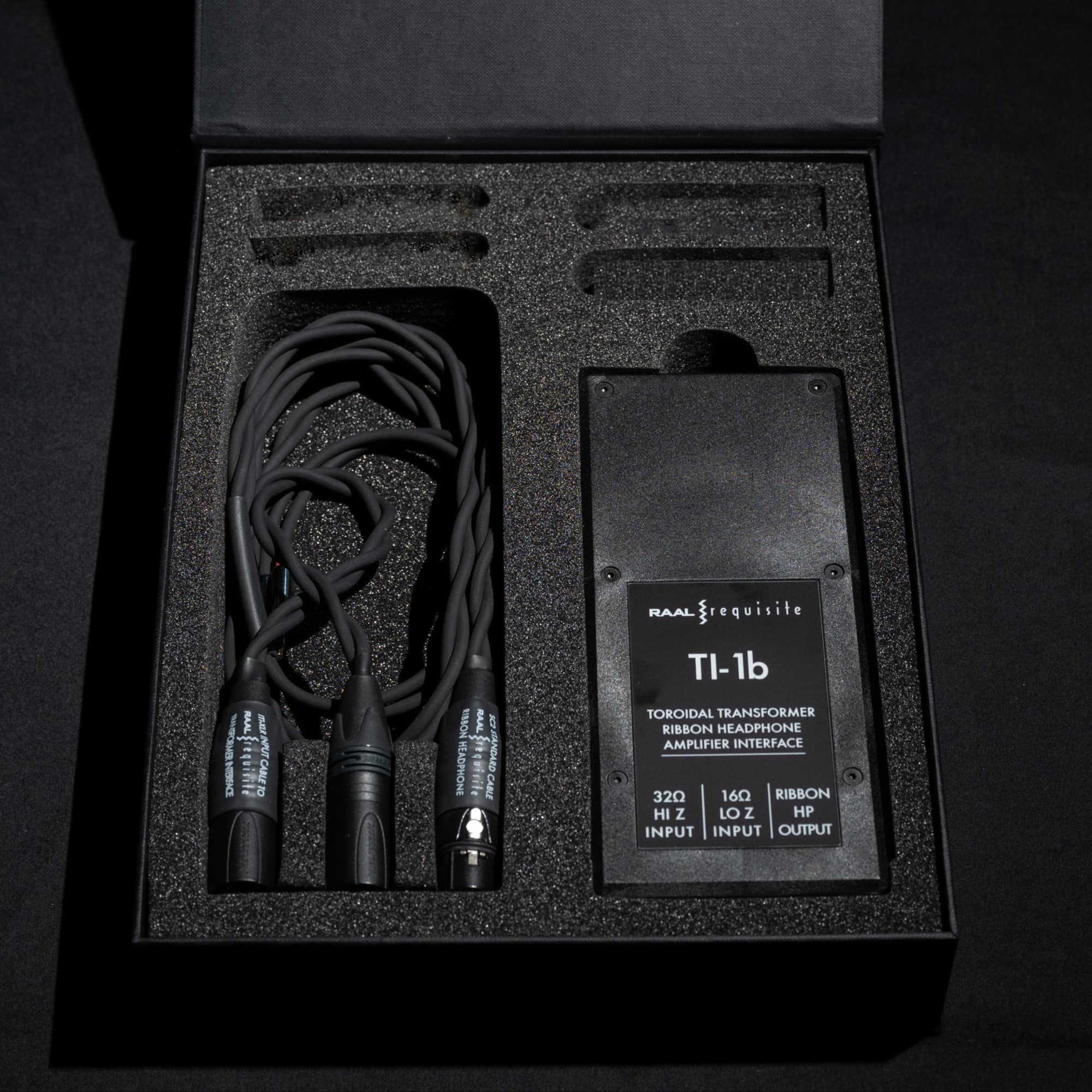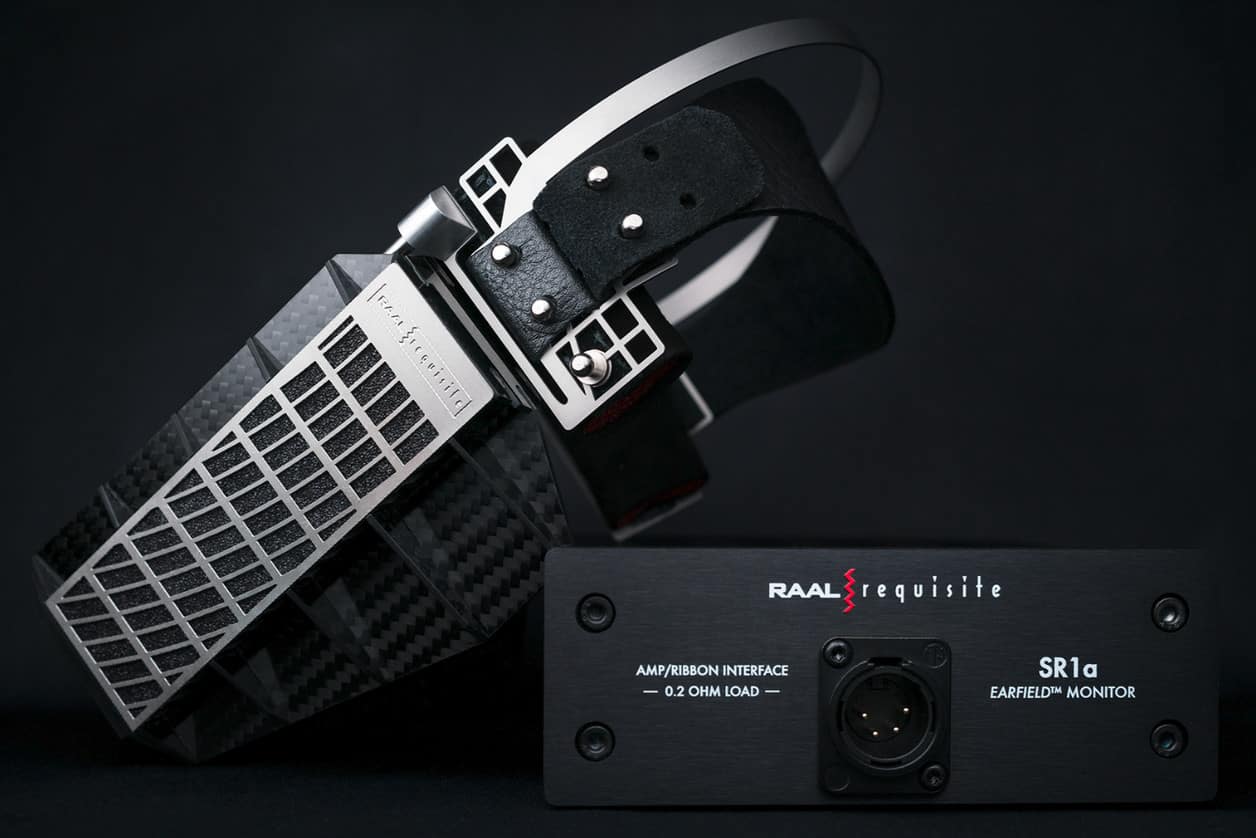I'd love to see a AKG k1000 review by Amir. God help me, one day I'll at least hear one. I'd love to add one to my collection, but before I hear one, it may not be prudent (at the current prices).
-
WANTED: Happy members who like to discuss audio and other topics related to our interest. Desire to learn and share knowledge of science required. There are many reviews of audio hardware and expert members to help answer your questions. Click here to have your audio equipment measured for free!
- Forums
- Audio, Audio, Audio!
- Headphones and Headphone Amplifier Reviews
- Headphone & IEM Reviews & Discussions
You are using an out of date browser. It may not display this or other websites correctly.
You should upgrade or use an alternative browser.
You should upgrade or use an alternative browser.
RAAL-requisite SR1a Ribbon Headphone Review
- Thread starter amirm
- Start date
I'd love to see a AKG k1000 review by Amir. God help me, one day I'll at least hear one. I'd love to add one to my collection, but before I hear one, it may not be prudent (at the current prices).
I owned two different K1000s and drove them with a variety of amps. They were very fun, some of my favorites, but I suspect they show their age now. I don't think there's much a K1000 does well that an HD800 does not do better, let alone the Raal.
You could get some very interesting spatial effects by spreading the wings out wide, but the sound suffered.
I owned two different K1000s and drove them with a variety of amps. They were very fun, some of my favorites, but I suspect they show their age now. I don't think there's much a K1000 does well that an HD800 does not do better, let alone the Raal.
You could get some very interesting spatial effects by spreading the wings out wide, but the sound suffered.
Gotcha! Would absolutely love to hear the other 2 - I do love the hd800s, and even the hd820, for what it does. But I've only spent a few hours with each, at best. So, in an objective sense, you enjoyed your RAAL experience? I have to admit they look cool, but as Amir said, I suspected a limited run like these to have literal sharp edges here and there LOL
I have a pretty vast collection, but much like the cars I collected (and now selling for this audio hobby), I was after the "oddballs" and the "vintage", for mostly the aesthetic... and if they sounded great, well that was a bonus. Gained a lot of surprises along the way. (Example, Sonic Pro 26's, blew me away. For a pair of knockoff headphones, they beat the real deal for me! (Pioneer SE-L40 clone)... Alas, lately I've exhausted my hunt for my "wacky" collection, and now focusing on the pricy ones. Which means I have to be careful lol... we're not talking about $5 - $300 cans any longer. The RAAL was one of my targets - oddball, but pricy. After Amir's review, I'm not so excited any longer lol.
SpaceMonkey
Active Member
- Joined
- Jan 11, 2020
- Messages
- 225
- Likes
- 214
Well, this is qute:
http://instagr.am/p/CSRpjPNITF7/
http://instagr.am/p/CSRpjPNITF7/
- Joined
- Feb 2, 2019
- Messages
- 398
- Likes
- 476
Circumaural SR1a confirmed by Danny:
- bass flat to 30 Hz
- 3" ribbon driver vs. 4" in the SR1a
jhenderson0107
Active Member
You're welcome to audition my pair if near Moorpark, 93021I'd love to see a AKG k1000 review by Amir. God help me, one day I'll at least hear one. I'd love to add one to my collection, but before I hear one, it may not be prudent (at the current prices).
...
I've checked and my listening level is typically not even 1 watt, and only around that when I'm hitting the bass notes in harder tracks, though I'll admit that I am typically a "quiet listening" sort.
...
On a last note: For my HE-6se headphones I have a Schiit Modius/Magnius stack which should arrive in the next week or so (I have also run the HE-6se on the stack listed above and while they sound good on that, it's much less portable), and I admit to being just curious to try the SR1a out with some appropriate extra resistors added in to see if that will drive them to the quiet levels I use.
OK, I posted this almost a year ago, and thought people might be curious about the result of connecting the Raal SR1a to a balanced headphone amp output. This seemed reasonable to try because indeed I'm generally a quiet listener to music.
NOTE: If you're not careful and you use this formula on a headphone amp which can't handle low impedances (~8 ohm for the SR1a using the resistor/impedance matcher box) well, you could damage your headphone amp, so fair warning!
Anyway, I made an adapter cable which has a 4-pin male XLR on one side to speaker cables with banana plugs on the other side. To test it, I then plugged the banana plugs into the resistor/impedance matcher box for my SR1a headphones, and finally plugged the 4-pin male XLR into the balanced headphone output of a Sabaj D5 DAC which I have (it was the easiest thing to plug in).
It sounds fabulous and there is even clearly headroom to spare when watching the RTA input on the Behringer DEQ2496 unit I use for digital equalization before the DAC. I turned it up a bit to the level I found uncomfortable with no apparent issues while watching the RTA meter to see how hard it was driving it. The resistor box for the SR1a remained stone cold through like 2 hours of music playing.
So quiet listeners rejoice, there is a formula to connect some of those super-high-fidelity-but-low-wattage headphone amps to drive an SR1a! It is useful to note that the highest quality playing happens near the higher end of the power delivery range, and this methodology gets you there without needing to use a multi-$1000 amp! I'll probably try some experiments on some other even higher-power headphone amps like the Schiit Magnius and Topping A30 Pro to see how they work as well.
IMO, the whole "you need at least a 100W amp for the SR1a " thing always seemed rather overblown unless you like to cause hearing damage, but YMMV, heh heh.
EDITs: clarified how the SR1a was connected to the balanced headphone amp.
Last edited:
...
NOTE: If you're not careful and you use this formula on a headphone amp which can't handle low impedances (~8 ohm for the SR1a using the resistor/impedance matcher box) well, you could damage your headphone amp, so fair warning!
...
It sounds fabulous and there is even clearly headroom to spare when watching the RTA input on the Behringer DEQ2496 unit I use for digital equalization before the DAC. I turned it up a bit to the level I found uncomfortable with no apparent issues while watching the RTA meter to see how hard it was driving it. The resistor box for the SR1a remained stone cold through like 2 hours of music playing.
So quiet listeners rejoice, there is a formula to connect some of those super-high-fidelity-but-low-wattage headphone amps to drive an SR1a! It is useful to note that the highest quality playing happens near the higher end of the power delivery range, and this methodology gets you there without needing to use a multi-$1000 amp! I'll probably try some experiments on some other even higher-power headphone amps like the Schiit Magnius and Topping A30 Pro to see how they work as well.
OK, after being a bit more critical and trying out my "try to stress corners of audio experience" listening list, I was detecting that the Sabaj D5's internal balanced headphone amp seemed to be running out of gas, especially on bass-heavy tracks... which is not really a surprise. My Behringer DEQ2496 EQ setup for the SR1a boosts low/sub-bass to get flatter response.
So this morning I did some listening using that list between the Sabaj D5 internal balanced headphone amp vs using the same Sabaj D5 as just a DAC using balanced audio connection then using a Schiit Magnius as the amp, and while the Sabaj D5's amp indeed sounds good enough that it's not immediately noticeable modulo the issue mentioned above, the Schiit Magnius doesn't seem to have any issues at all and matches my subjective memory of using world-class speaker amps with the SR1a, even run louder than I'm comfortable listening to. Looking up the stats on the Magnius and their testing suggests this should be the case, as it has both very good voltage and power delivery capability.
Having said the above, the next test will be to compare it to my Purifi 1ET400A speaker amp, but that will probably take a few days to arrange. Ideally of course, I'd measure the actual output voltage and power used to confirm that the Magnius is truly in a non-distorting range, but we'll see if I can do that reasonably with the equipment I've got on-hand.
EDIT: I just noted that my Behringer DEQ2496 RTA source was set wrong, so last night I was looking at the pre-EQed levels, and the post-EQed bass levels were indeed high enough that I would doubt the Sabaj D5's amp could handle it properly.
Last edited:
So this morning I did some listening using that list between the Sabaj D5 internal balanced headphone amp vs using the same Sabaj D5 as just a DAC using balanced audio connection then using a Schiit Magnius as the amp, and while the Sabaj D5's amp indeed sounds good enough that it's not immediately noticeable modulo the issue mentioned above, the Schiit Magnius doesn't seem to have any issues at all and matches my subjective memory of using world-class speaker amps with the SR1a, even run louder than I'm comfortable listening to. Looking up the stats on the Magnius and their testing suggests this should be the case, as it has both very good voltage and power delivery capability.
Having said the above, the next test will be to compare it to my Purifi 1ET400A speaker amp, but that will probably take a few days to arrange. Ideally of course, I'd measure the actual output voltage and power used to confirm that the Magnius is truly in a non-distorting range, but we'll see if I can do that reasonably with the equipment I've got on-hand.
I asked Schiit if using the Magnius output at 8 ohm (average, 6 ohm in bass/mid-bass region, up to 10 ohm in high frequencies) for the Raal SR1a speaker amp impedance matching box was ok without always worrying about burning out the amp.
Their response was that they don't recommend this but as long as it functions it should be ok.
They of course brought up that the Jotunheim R was built for that purpose and recommended using that.
I'm not trying to get people to not use the Jotunheim R. It's a fine product that gives you command of the full volume range the SR1a is capable of, also allowing you to get rid of the pesky impedance matching box, and in any case giving that full volume range while being much more reasonable in power consumption.
It's just nice to know there are other less expensive options in more restricted domains like quiet(-ish) listening. The specs of the Magnius say that for example ~75db average listening with the normal ~20db peaks would work great, and that is louder than I use.
- Joined
- Feb 2, 2019
- Messages
- 398
- Likes
- 476
RAAL has a new "interface box" allowing use with conventional headphone amps:Most of the power is dissipated in the 'interface box' which basically is a huge resistor + capacitor network = about 7 Ohm.

TI-1b • RAAL-requisite
Transformer Ribbon/Amp Interface in Molded Box, includes: Cables (SC2 & ITI-XLR)
 raalrequisite.com
raalrequisite.com
Would that be more efficient than the previous with less power dissipated as heat?
SpaceMonkey
Active Member
- Joined
- Jan 11, 2020
- Messages
- 225
- Likes
- 214
Of course, this one will be much less resource hungry.RAAL has a new "interface box" allowing use with conventional headphone amps:

TI-1b • RAAL-requisite
Transformer Ribbon/Amp Interface in Molded Box, includes: Cables (SC2 & ITI-XLR)raalrequisite.com
Would that be more efficient than the previous with less power dissipated as heat?
solderdude
Grand Contributor
RAAL has a new "interface box" allowing use with conventional headphone amps:

TI-1b • RAAL-requisite
Transformer Ribbon/Amp Interface in Molded Box, includes: Cables (SC2 & ITI-XLR)raalrequisite.com
Would that be more efficient than the previous with less power dissipated as heat?
Yes, you can now even drive it with a few watt from a normal (will >1W in 32 ohm) headphone amp.
The speaker adapter also had some EQ in it which this one does not have. (At least that's what I got from the reading material).
You will have to use an XLR or RCA input filter on the used amp to get the right sound.
I figure they could not combine this with the toroid transformer in the box.
It also comes with a new cable. Obviously they had some issues with the original cable which (I presume) had a too high resistance eating up power. Not a problem using 100W power amp but driving it from a low wattage means the cable must not consume too much.
I ordered one of the new TI-1a adapter boxes yesterday after the announcement, and should have it in maybe 1 1/2 to 2 weeks from what they told me, and will report initial findings back to the forum.Yes, you can now even drive it with a few watt from a normal (will >1W in 32 ohm) headphone amp.
The speaker adapter also had some EQ in it which this one does not have. (At least that's what I got from the reading material).
You will have to use an XLR or RCA input filter on the used amp to get the right sound.
I figure they could not combine this with the toroid transformer in the box.
It also comes with a new cable. Obviously they had some issues with the original cable which (I presume) had a too high resistance eating up power. Not a problem using 100W power amp but driving it from a low wattage means the cable must not consume too much.
Personally, I like the idea of the OB compensation not being done in analog in the box. I'm already doing some digital correction to compensate for peaks and valleys and it's not hard to add the OB as well to keep it all in the digital domain.
- Joined
- Feb 2, 2019
- Messages
- 398
- Likes
- 476
The EQ (aka open baffle compensation) is now done via adapters. The NEWS page has more pics:The speaker adapter also had some EQ in it which this one does not have. (At least that's what I got from the reading material).

News • RAAL-requisite
Event Date: Fri-Sun April 12-14, 2024 – AXPONA Event Details Meet us at Booth 8116 Introducing Next-Generation, Multi-Driver, True-Ribbon Headphones Developing fine ribbon tweeters since 1995 and World’s first ribbon headphones, since 2018. RAAL 1995 is our top-performance brand, combining all...
 raalrequisite.com
raalrequisite.com
I ordered one of the new TI-1a adapter boxes yesterday after the announcement, and should have it in maybe 1 1/2 to 2 weeks from what they told me, and will report initial findings back to the forum.
Personally, I like the idea of the OB compensation not being done in analog in the box. I'm already doing some digital correction to compensate for peaks and valleys and it's not hard to add the OB as well to keep it all in the digital domain.
FYI to those on this forum. I got the TI-1a and modulo the question of how you do the OB compensation, in my current limited listening sessions, it sounds close enough to identical to the old amp/ribbon interface box that I couldn't really tell the difference except that it's of course much louder at the same input levels.
For comparison purposes, I modded my old amp/ribbon interface box to allow removing the OB compensation with a switch, then running with that set the OB compensation to off in the box and did it via digital correction so it would be as close to the same comparison as possible, just changing the volume.
Simplest way to describe the result is to say that with the TI-1a you get a "very insensitive headphone" roughly similar to for example my HE-6se, vs. with the old amp/ribbon interface box it's a 90db/watt speaker. So, LOTs more sensitivity with the same audio quality.
Similar threads
- Replies
- 134
- Views
- 22K
- Replies
- 162
- Views
- 18K
- Replies
- 39
- Views
- 9K
- Replies
- 107
- Views
- 30K
- Replies
- 1K
- Views
- 155K
